最新中国饮食文化中英文PPT精选文档
美食文化英语ppt课件
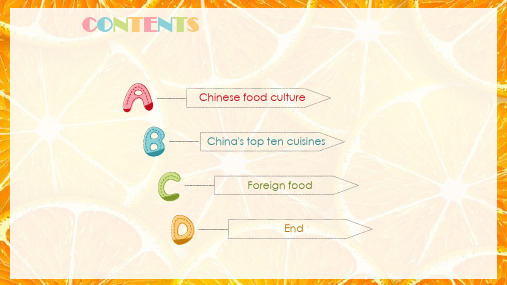
苏菜特征选料严谨,制作精致,口味适中,四季分明。在烹调技术上擅长炖焖、烩、窝、烧、炒、又重视调汤,保持原汁,风味清鲜,适应面广,浓而不腻、淡而不薄,酥烂脱骨,滑嫩爽脆。
苏菜烹调技艺以炖、焖、煨著称;重视调汤,保持原汁。
Is famous for its cooking skills to stew, braised, simmer; Attaches great importance to the soup, keep juice. Formerly jiangsu and zhejiang cuisine, is the middle and lower reaches of the Yangtze river region famous cuisines in China, its broad geographical coverage, including jiangsu, zhejiang, anhui and Shanghai today, and parts of jiangxi, henan, it has "southeast first JiaWei", "to the United States of the world" reputation, reputation spread far from home and abroad.
中国饮食文化英文PPT
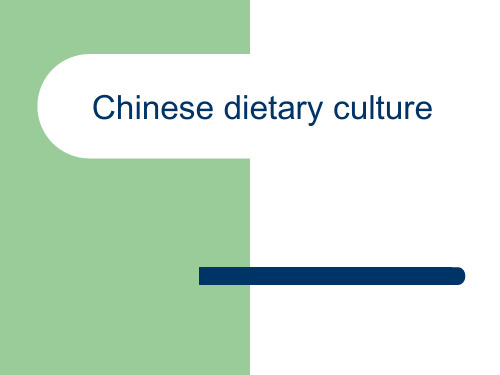
in the western’s diet structures, their consumptions of meat are almost ten times than the Chinese’s while Chinese vegetable consumption are six times than the western's.
Chinese dietary culture
Outline
Part 1
Features
Part 2
Differences
Part 3
Cultural & Chinese delicacies
Features
characteristics
on surface
connotation
Characteristics on surface
what’more, the western won't eat some parts of animals, such as organs(内脏), feets(脚爪), heads (头). Instead, these parts are delicious for chinese. such as chiken toe(鸡爪)
poeple often eat in winter
Tofu looks like bear's pow
Beef shaped in a cow
Delicacy
Beauty
Cultural elements related to Chinese delicacies
淮扬菜
江 苏 菜
粤菜
湘菜
福 建 菜
中国饮食文化英文版
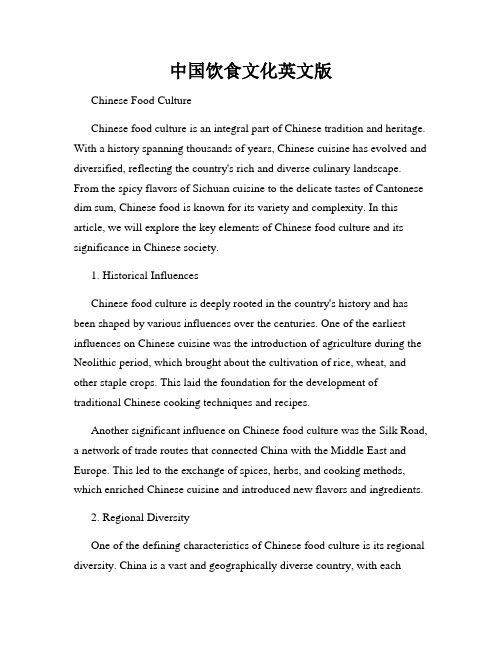
中国饮食文化英文版Chinese Food CultureChinese food culture is an integral part of Chinese tradition and heritage. With a history spanning thousands of years, Chinese cuisine has evolved and diversified, reflecting the country's rich and diverse culinary landscape. From the spicy flavors of Sichuan cuisine to the delicate tastes of Cantonese dim sum, Chinese food is known for its variety and complexity. In this article, we will explore the key elements of Chinese food culture and its significance in Chinese society.1. Historical InfluencesChinese food culture is deeply rooted in the country's history and has been shaped by various influences over the centuries. One of the earliest influences on Chinese cuisine was the introduction of agriculture during the Neolithic period, which brought about the cultivation of rice, wheat, and other staple crops. This laid the foundation for the development of traditional Chinese cooking techniques and recipes.Another significant influence on Chinese food culture was the Silk Road, a network of trade routes that connected China with the Middle East and Europe. This led to the exchange of spices, herbs, and cooking methods, which enriched Chinese cuisine and introduced new flavors and ingredients.2. Regional DiversityOne of the defining characteristics of Chinese food culture is its regional diversity. China is a vast and geographically diverse country, with eachregion having its own unique culinary traditions and specialties. For example, the spicy and numbing flavors of Sichuan cuisine are a stark contrast to the light and fresh flavors of Shandong cuisine.Each region in China has its own distinct ingredients, cooking styles, and flavor profiles, which are influenced by local customs, climate, and geography. This regional diversity has contributed to the richness and depth of Chinese cuisine, making it one of the most diverse and vibrant culinary traditions in the world.3. Social SignificanceIn Chinese culture, food is not just sustenance but also a symbol of social connections and harmony. Shared meals play a central role in Chinese social life, bringing families and communities together to celebrate festivals, weddings, and other important occasions. The act of preparing and sharing food is seen as a way to strengthen bonds and foster relationships.Food also holds symbolic significance in Chinese culture, with certain dishes and ingredients representing prosperity, happiness, and good fortune. For example, fish is often served whole during Lunar New Year celebrations to symbolize abundance and prosperity, while dumplings are eaten to usher in wealth and good luck.4. Traditional PracticesChinese food culture is steeped in tradition, with many customs and practices that have been passed down through generations. One such practice is the concept of "balance" in Chinese cuisine, which emphasizes the harmony of flavors, textures, and colors in a meal. It is believed that a well-balanced meal not only nourishes the body but also balances the body's energy and promotes good health.Another traditional practice in Chinese food culture is the use of food as medicine. Many ingredients in Chinese cuisine, such as ginseng, goji berries, and lotus seeds, are believed to have healing properties and are used in traditional Chinese medicine to treat various ailments.5. Modern TrendsWhile Chinese food culture is steeped in tradition, it has also evolved and adapted to changing tastes and lifestyles. In recent years, there has been a growing interest in healthy eating and sustainable food practices in China, leading to the popularity of organic and locally sourced ingredients.The rise of food delivery services and online platforms has also transformed the way Chinese people eat, making it easier to access a wide range of cuisines from the comfort of their homes. Despite these changes, traditional Chinese food culture continues to thrive, with a renewed interest in preserving and promoting the country's culinary heritage.In conclusion, Chinese food culture is a reflection of the country's rich history, regional diversity, and social values. With its emphasis on balance, harmony, and tradition, Chinese cuisine remains one of the most vibrant and enduring culinary traditions in the world. By exploring the key elements of Chinese food culture, we can gain a deeper appreciation for the role that food plays in Chinese society and its significance in everyday life.。
中国传统饮食文化及餐桌礼仪英文ppt
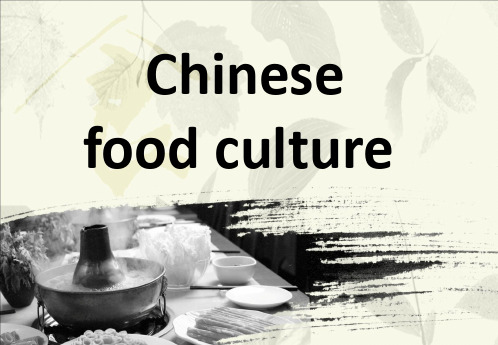
•
• ZheJiang Cuisine 浙江菜系
Comprising local cuisines of Hangzhou, Ningbo and Shaoxing, Zhejiang Cuisine, not greasy, wins its reputation for
freshness, tenderness, softness, smoothness of its dishes
ligห้องสมุดไป่ตู้t, not too bland. • 淮阳菜的特色是淡,鲜,甜,雅。江苏菜 系以其精选的原料,精细的准备,不辣不温的口
not-too-bland
taste. If the flavor is strong, it isn't too heavy; if
感而出名,味道强而不重,淡而不温。
• Hunan cuisine 湖南菜系
•
中 湖南菜系由湘江地区,洞亭湖和湘西的地方 国 菜肴组成。它以其极辣的味道为特色。红辣椒, 风 青辣椒和青葱在这一菜系中的必备品 呀
• Sichuan Cuisine四川菜系
•
Sichuan Cuisine, Characterized by its
spicy and pungent flavor, Sichuan
国 风 呀
On the fifth day of the fifth lunar month, the Dragon Boat Festival,
zongzi, or glutinous rice cake
wrapped in reed leaf is the festivity food. The Dragon Boat Festival has had more than 2,000 years of history in China.
中国传统饮食文化及餐桌礼仪英文ppt

中 国 风 中 国 风 呀
Second to the Spring Festival in importance and grandness is the Midautumn Festival, when people get together
to have the moon cake. Because of its round shape like that of the moon, the moon cake symbolizes union. Every Midautumn, when the bright round moon is hanging above, and all homes are united, people enjoy moon cakes while observing the moon
Chinese food culture
Catalog
• The traditional staple food.
• The traditional festival food
• • Eight regional cuisines Typical dishes
•
Summary
Chinese traditional staple
cuisine, prolific of tastes, emphasizes on the use of chili. Pepper and prickly ash also never fail to accompany, producing typical exciting tastes. 世界上最著名的中国菜系之一。四川菜系以其
usually. Soups are given much emphasis in Shangdong
中西饮食文化差异 英文版PPT课件

• Dicing (切丁)
Mincing (磨)
• Cutting into chunks (块)
Quick-fry over high heat (爆)
• Steaming in a container (隔水炖) stir-fry (炒),
• Crisp frying with syrup (拔丝) Quick boiling (焯)
38
dietchinesepaymoreattentiondietchinesepaymoreattentionformpayattentioncoloraromatasteformpayattentioncoloraromatastewesternpaymoreattentionnutritionwesternpaymoreattentionfoodratherthanfoodratherthanmorewesternmorepracticalpaymorepracticalpaymoreattentionnutritionattentionfoodqualityfoodqualitycookingwayscookingwaysslicing片strappingquickfryoverhighheatcontainer隔水炖stirfrycrispfryingsyrup拔丝quickboilingdeepfryshallowfry煎boil煮roastbroilbakesmokebarbecue烧烤12grill或broil烧烤roastbake烘培烘烤panbroil锅烧烤gratindeepfry深油炸panfry浅油炸saute煎炒boil沸煮simmer中火慢煮steam蒸blanch烫煮poach小火慢煮13namefestivalfoodfestivalfood25interactionduringmealinteractionduringmatterwhatmatterwhatonlyoneformsittingtogethersharingonefeastonlyoneformsittingtogethersharingonefeast
英文介绍中国美食(共35张PPT)
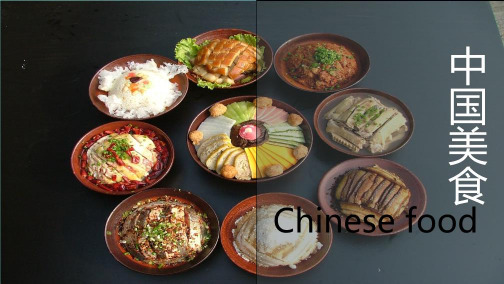
• 2) The meal must be harmonious, which means that different colored foods must complement each other and that taste and texture should contrast.
18
Peppery and hot chicken辣炒鸡丁
湘
taste shrimp
Steamed Fish Head with Diced 口味虾 Hot Red Peppers
剁椒鱼头
Famous dishes of hunan cuisine
19
Jiangsu Cuisine 苏菜
• 1000 years ago, catering industry highly developed. • Geographically, between south and north, combining various cooking
.广东人吃天上
飞的,除了飞 机;地上爬的, 除了火车;水 里游的,除了 船儿。
In fact, people in Northern China often say that Cantonese people will eat anything that flies except airplanes, anything that moves on the ground except trains, and anything that moves in the water except boats
Cutting of the material is the key factor for a good dish
中国传统饮食文化及餐桌礼仪英文ppt
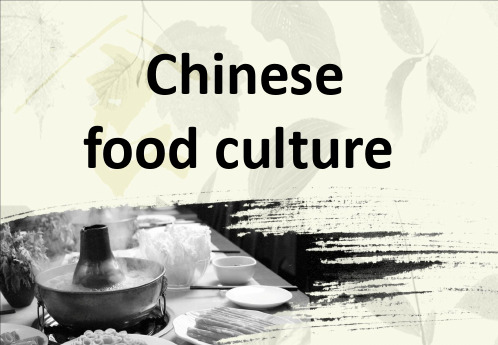
菜肴组成。它以其极 的味道为特色。红风辣椒,
青辣椒和青葱在这一菜系中的必备品 呀
• Sichuan Cuisine四川菜系
•
Sichuan Cuisine, Characterized by its
spicy and pungent flavor, Sichuan
cuisine, prolific of tastes, emphasizes on the use
呀
• ZheJiang Cuisine 浙江菜系
•
Comprising local cuisines of
Hangzhou, Ningbo and Shaoxing, Zhejiang Cuisine,
not greasy, wins its reputation for
freshness, tenderness,
Lantern Festival is rice glue
ball(元宵). The rice glue
ball’s shape is just like the full
moon appears in the sky. This
kind of dessert is especially
welcomed by children.
风 呀
Second to the Spring Festival in
importance and grandness is the Mid-
autumn Festival, when people get together
to have the moon cake. Because of its
辣 脆而闻名,通常很 ,注重汤品。
•
中国饮食文化英文演讲ppt
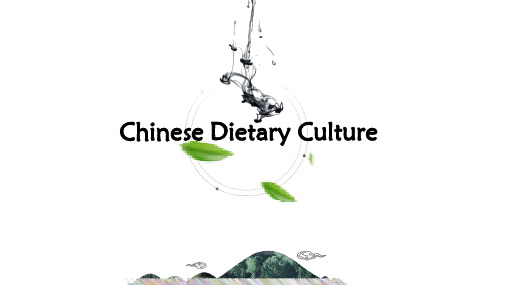
C目 录 ontent
1 Characteristics 2 Classifications 3 Conclusions
1
PART ONE
Characteristics
As the old saying goes:
Man sees food as the first priority
鲁菜 川菜
粤菜 苏菜 闽菜 浙菜 湘菜 徽菜
Min cuisine : light,soft
Shandong cuisine: Salty,Fresh,Original
Sichuan cuisine: hot and numbing flavor
3
PART FOUR
Conclusions
As we all know:
Summer : cold and dressed with sauce
Winter : stewed dishes
Aesthetic feeling
色-color 香-flavor 味-taste 形-shape 意-meaning
Combination of food and medicine
谢谢XIE XIE
Compared with the foreign food culture, I think the Chinese food culture is the most characteristic and the most cultural flavor.
Chinese Dietary Culture contains the measures Chinese people take to understand things.
中国传统饮食文化英文版ppt课件

crispness and tenderness. Shangdong
dishes tastes pungent usually. Soups are given
much emphasis in Shangdong dishes.
•
由济南菜系和胶东菜系组成,以其香,鲜,
辣 嫩,脆而闻名,通常很 ,注重汤品。
•
事实上,中国北方人常说,广东人
吃天上飞的,除了飞机;地上爬的,除
了火车;水里游的,除了船儿。
• ZheJiang Cuisine 浙江菜系
•
Comprising local cuisines of
Hangzhou, Ningbo and Shaoxing, Zhejiang
Cuisine, not greasy, wins its reputation for
eight regional cuisines :
Shandong
Cuisine 山东菜系
Sichuan
Cuisine 四川菜系
Cantonese
food 广东菜系
Fujian
Cuisine 福建菜系
Jiangsu Cuisine 江苏菜 系
Hunan
cuisine 湖南菜系
Anhui
Cuisine 安徽菜系
呀
但也加入猪肉,萝卜,白菜,
粉丝,海藻,豆腐等。
Topic introduce
The traditional staple food. The traditional festival food Eight regional cuisines Table manner
20
Chinese food can be roughly divided into
中国饮食文化 英文
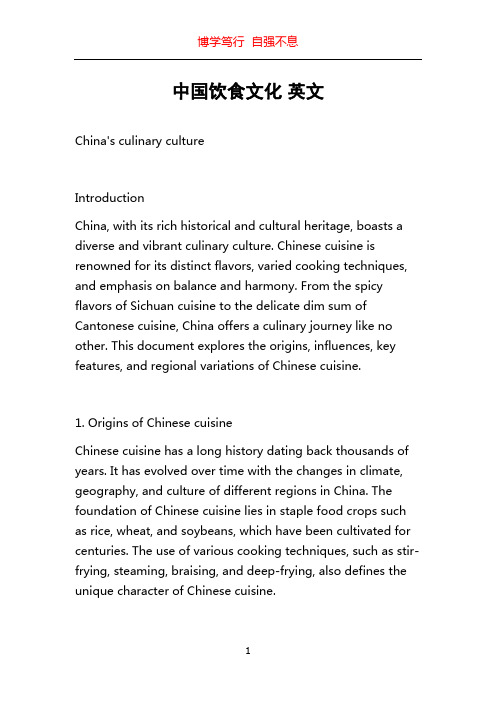
中国饮食文化英文China's culinary cultureIntroductionChina, with its rich historical and cultural heritage, boasts a diverse and vibrant culinary culture. Chinese cuisine is renowned for its distinct flavors, varied cooking techniques, and emphasis on balance and harmony. From the spicy flavors of Sichuan cuisine to the delicate dim sum of Cantonese cuisine, China offers a culinary journey like no other. This document explores the origins, influences, key features, and regional variations of Chinese cuisine.1. Origins of Chinese cuisineChinese cuisine has a long history dating back thousands of years. It has evolved over time with the changes in climate, geography, and culture of different regions in China. The foundation of Chinese cuisine lies in staple food crops such as rice, wheat, and soybeans, which have been cultivated for centuries. The use of various cooking techniques, such as stir-frying, steaming, braising, and deep-frying, also defines the unique character of Chinese cuisine.2. Influences on Chinese cuisineChinese cuisine has been influenced by various factors throughout history. The Silk Road, an ancient trade route connecting China with the West, played a significant role in introducing new ingredients and cooking techniques to Chinese cuisine. The Mongol rule during the Yuan Dynasty brought an influx of Central Asian flavors, while the Manchu rulers of the Qing Dynasty influenced the development of Manchurian-style cuisine. Additionally, Chinese cuisine has been shaped by the influence of neighboring countries such as Japan, Korea, and Vietnam.3. Key features of Chinese cuisineChinese cuisine is characterized by its emphasis on harmony and balance in flavors, colors, and food textures. The concept of Yin and Yang, representing the balance of contrasting elements, is deeply embedded in Chinese culinary traditions. This balance is achieved through the combination of different flavors, including sweet, salty, sour, bitter, and umami. Chinese cuisine also places great importance on the freshness and quality of ingredients, with an emphasis on seasonal produce and locally sourced meats and vegetables.4. Regional variations of Chinese cuisineChina's vast size and diverse geography have given rise to distinct regional culinary traditions. Each region has its own unique flavors, cooking techniques, and ingredients. Some of the most renowned regional cuisines include Sichuan cuisine, known for its bold and spicy flavors; Cantonese cuisine, famous for its fresh seafood and delicate dim sum; and Shandong cuisine, which emphasizes the use of seafood and a wide range of cooking methods. Other notable regional cuisines include Hunan, Fujian, Jiangsu, and Zhejiang.5. Cultural significance of Chinese cuisineChinese cuisine holds significant cultural and social importance in China. Food is seen as more than just sustenance; it is a reflection of social status, harmony, and hospitality. Chinese banquets, with their elaborate presentation and wide variety of dishes, are an integral part of Chinese culture and are often held during festive occasions or to celebrate special events. Moreover, the shared act of consuming food is seen as a way to strengthen social bonds and foster harmony within families and communities.ConclusionChinese cuisine is a testament to China's rich culinary traditions and cultural heritage. From the abundance of flavors and textures to the artful presentation and regional variations, Chinese cuisine offers a wealth of culinaryexperiences. Whether indulging in the spicy and bold flavors of Sichuan cuisine or savoring the delicate and refined dim sum of Cantonese cuisine, exploring Chinese cuisine is a journey that will truly tantalize the taste buds.。
- 1、下载文档前请自行甄别文档内容的完整性,平台不提供额外的编辑、内容补充、找答案等附加服务。
- 2、"仅部分预览"的文档,不可在线预览部分如存在完整性等问题,可反馈申请退款(可完整预览的文档不适用该条件!)。
- 3、如文档侵犯您的权益,请联系客服反馈,我们会尽快为您处理(人工客服工作时间:9:00-18:30)。
very particular about what to eat in the festival. During
the festivals, they organized appropriate eating activities
to strengthen kinship ties, showed their best wishes
From the History, China's food culture stretching more than 170 million years, is divided into raw food, cooked food, natural cooking, science and cooking four stages of development, introduction of more than 60,000 kinds of traditional dishes point, more than 20,000 kinds of industrial food, access to "Cooking kingdom" in the world.
moon cake
Байду номын сангаас
The round shape indicates reunite and happiness,
and people eat them to denote union, harmony and happiness for the family.圆形表示团聚和快乐,人们吃 它们表示联盟,和谐和幸福的家庭。
and pursuit of hope, and commemorate the ancestors.
Spring Festival
Dumplings Fish
Wonton 馄饨
New Year cake
Lantern festival and Mid Autumn Festival
rice glue ball /sweet dumpling元宵
Dietary practices of celebration
The birth of the children, the birthday of the olds and the marriage are important moments for celebration, though the size can’t compare with the National festivals, they reflect the customs of life with a strong local color. 孩子的出生,生日和结 婚庆典 等 重要时刻,尽管规模比不上国家节日,它们 也反映了强烈的地方生活的特色。
Cold Food Festival
Dragon Boat Festival端午节
People eat rice dumpling to show their deep memory of Qu Yuan 人们吃粽子来显示他们的深 刻的纪念屈原
On that day only cold food is served to commemorate our ancestors 为了纪念我们的祖 先在那一天只吃冷的食物。
Celebration for the birth of a child
In Central China, if a baby is born, his father will send Red Boiled Eggs to announce the news. An even number, usually six or eight Red Boiled Eggs with a black point dotted on one end will be delivered for a boy and an odd number, usually five or seven without black point for a girl. Through this way, the people express the joy of the birth of the child. 中国孩子出生,父亲将用红 鸡蛋宣布这一消息,通常六个或八个红 色煮鸡蛋,黑色点点缀代表男孩,通常5 或7没有黑色的鸡蛋代表女孩。通过这 种方式,人们表达孩子的出生的喜悦。
In traditional Chinese culture and education in the philosophy of yin and yang, the Confucian ethical concepts, theory of traditional Chinese medicine nutrition regimen, as well as cultural and artistic achievements, food aesthetic fashion, national character traits under the influence of many factors to create the annals of the Chinese cooking skills, the formation of extensive and profound Chinese food culture. 在中国传统文化和教育哲学的阴 阳,儒家伦理概念,中医理论营养方案,以 及文化和艺术成就,食物的审美时尚,民族 性格特征的影响下许多因素创造中国烹 饪技能上,形成博大精深的中国饮食文化
从历史、中国食品文化延伸超过1.7亿 年,分为生食、熟食、自然烹饪、科学 烹饪4个发展阶段,推出60000多种传统 菜肴,20000多种工业食物,获得“烹饪 王国”。
Festival eating habit
Since ancient times,
all Chinese ethnic
groups like to combine food with festivals, and are
